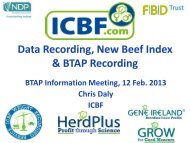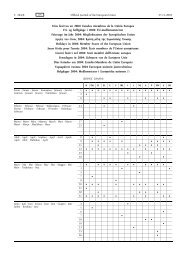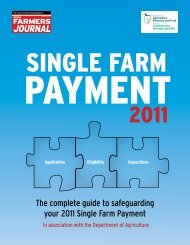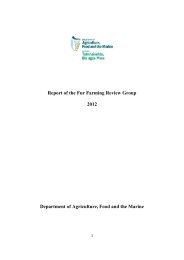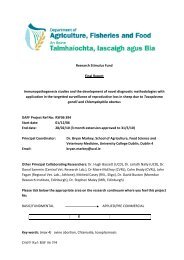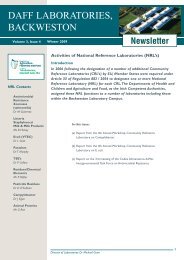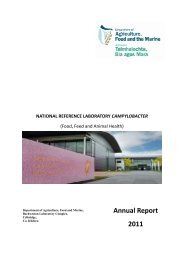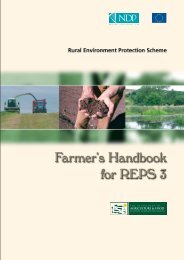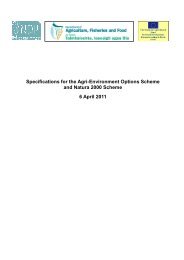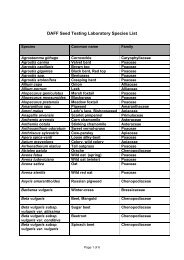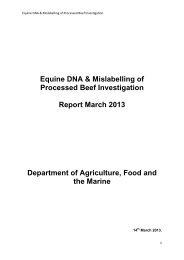Food Research Ireland - Department of Agriculture
Food Research Ireland - Department of Agriculture
Food Research Ireland - Department of Agriculture
Create successful ePaper yourself
Turn your PDF publications into a flip-book with our unique Google optimized e-Paper software.
■ Evaluating the effectiveness <strong>of</strong> alternative heating methods for<br />
reducing energy consumption (with reductions in associated<br />
GHG emissions and benefits in terms <strong>of</strong> leaner manufacturing) in food<br />
processing environments while producing high quality products;<br />
■ The development <strong>of</strong> novel sensing technology for improved<br />
process control based for example, on hyperspectral imaging.<br />
4.1.4 KEY INVESTMENT AREA - ENCAPSULATION<br />
Microencapsulation was a key focus <strong>of</strong> earlier national food research<br />
efforts, including large industry-led initiatives to protect and deliver<br />
bioactive compounds. <strong>Research</strong> expertise and a significant research<br />
infrastructure was established through nationally funded projects.<br />
Excellent progress has been made in the design and manufacture <strong>of</strong><br />
encapsulating matrices and novel methods have been developed to<br />
assess bioavailability and to enhance the absorption <strong>of</strong> bioactives. New<br />
encapsulation technology research will be able to position <strong>Ireland</strong>’s<br />
ingredient industry as market leaders in encapsulated bioactive<br />
ingredients capable <strong>of</strong> supplying the global food industry. This research<br />
will also deliver on the opportunity to develop novel nano-vectorised<br />
delivery systems. To realise these major opportunities, further<br />
development <strong>of</strong> encapsulation technology is required.<br />
<strong>Research</strong> objectives<br />
■ Protect heat sensitive ingredients such as enzymes and bioactives<br />
during heat processing and other harsh regimes used in the<br />
industrial manufacture <strong>of</strong> food products;<br />
■ Control the interaction <strong>of</strong> bioactives with the food matrix, ensuring a<br />
timed-release delivery;<br />
■ Protect ingredients from early digestion in the gastro-intestinal tract;<br />
■ Target release the ingredient in order to optimise bioavailability in<br />
the gut;<br />
■ Mask the taste <strong>of</strong> ingredients that have a strong or unacceptable taste<br />
by providing a barrier between our taste buds and the ingredient;<br />
■ Use <strong>of</strong> novel technologies to enhance shelf life <strong>of</strong> seafood products.<br />
4.1.5 KEY INVESTMENT AREA - NANOTECHNOLOGY<br />
State investment in research to support the development <strong>of</strong><br />
nanotechnology is on a par with that <strong>of</strong> the US and Germany; as a result,<br />
the quality <strong>of</strong> Irish nanotechnology research is recognised internationally.<br />
Public health and life science are the main economic drivers <strong>of</strong><br />
nanotechnology. Despite having expertise in nanotechnology research,<br />
there remains a limited application in food related areas in <strong>Ireland</strong>. This<br />
is in direct contrast to the activities in other European countries where<br />
food companies have a direct involvement in nanotechnology research.<br />
Nanotechnology <strong>of</strong>fers the potential to enhance the safety, shelf-life and<br />
health benefits <strong>of</strong> food and <strong>of</strong>fers the industry new processing<br />
capabilities, which can enhance competitiveness. To ensure that <strong>Ireland</strong>’s<br />
investment in nanotechnology can be translated in to food research,<br />
investment is required.<br />
<strong>Research</strong> objectives:<br />
■ Risk/Benefit assessment <strong>of</strong> nanotechnology in foods;<br />
■ Identification <strong>of</strong> the safety aspects <strong>of</strong> nanotechnology in food<br />
product development and processing;<br />
■ Nanoprocessing as a means <strong>of</strong> concentrating bioactives;<br />
■ Targeted delivery <strong>of</strong> nutrients using nanocapsules;<br />
■ Detection <strong>of</strong> food contamination using nanosensors for shelf life<br />
improvement;<br />
■ Nanotechnology to create packaging which will extend the<br />
shelf-life <strong>of</strong> food and enhance food safety.<br />
<strong>Food</strong> <strong>Research</strong> <strong>Ireland</strong><br />
▼<br />
29



